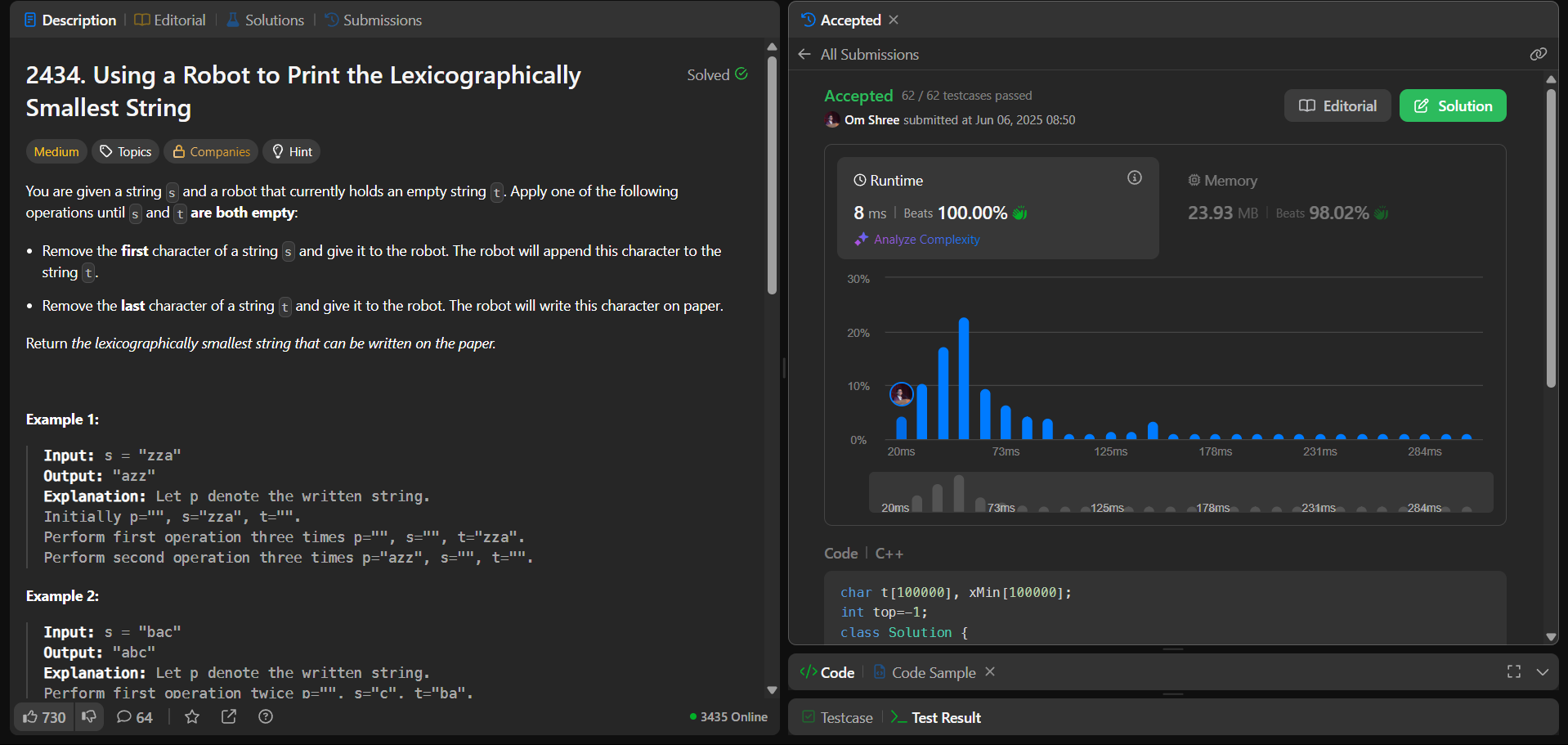Hey, tech explorers! 🌟 Today, let’s dive into a fun and slightly sneaky greedy problem — LeetCode 2434: Using a Robot to Print the Lexicographically Smallest String. We'll crack it open using an intuitive stack-based greedy approach. 💡
📜 Problem Overview
LeetCode 2434: Using a Robot to Print the Lexicographically Smallest String
Given a string s, you control a robot that maintains an auxiliary string t (initially empty). The robot can perform two operations:
Move operation: Remove the first character from
sand append it to the end oftWrite operation: Remove the last character from
tand write it to the result
The goal is to determine the lexicographically smallest string that can be written by performing these operations until both s and t are empty.
Example Walkthrough
Input: s = "bac"
Step 1: Move 'b' from s to t → s="ac", t="b"
Step 2: Move 'a' from s to t → s="c", t="ba"
Step 3: Write 'a' from t → s="c", t="b", result="a"
Step 4: Move 'c' from s to t → s="", t="bc"
Step 5: Write 'b' from t → s="", t="c", result="ab"
Step 6: Write 'c' from t → s="", t="", result="abc"
Output: "abc"
🧠 Algorithm Intuition
The key insight is to use a greedy strategy: we should write a character from t to the result when it's smaller than or equal to any character we might encounter later in s. This requires:
Preprocessing: Calculate the minimum character from each position to the end of
sGreedy decision: At each step, write from
tif the top character is ≤ the minimum remaining character insStack simulation: Use a stack to represent the auxiliary string
t
⚙️ Solution Implementation
C++ Solution
class Solution {
public:
string robotWithString(string s) {
int n = s.size();
vector<char> minSuffix(n);
// Build minimum suffix array
minSuffix[n-1] = s[n-1];
for (int i = n-2; i >= 0; i--) {
minSuffix[i] = min(s[i], minSuffix[i+1]);
}
string result;
stack<char> t;
result.reserve(n); // Optimize memory allocation
for (int i = 0; i < n; i++) {
t.push(s[i]);
// Write from stack while beneficial
while (!t.empty() && (i == n-1 || t.top() <= minSuffix[i+1])) {
result += t.top();
t.pop();
}
}
return result;
}
};
JavaScript Solution
function robotWithString(s) {
const n = s.length;
const minSuffix = new Array(n);
// Build minimum suffix array
minSuffix[n-1] = s[n-1];
for (let i = n-2; i >= 0; i--) {
minSuffix[i] = s[i] < minSuffix[i+1] ? s[i] : minSuffix[i+1];
}
const result = [];
const stack = [];
for (let i = 0; i < n; i++) {
stack.push(s[i]);
// Write from stack while beneficial
while (stack.length && (i === n-1 || stack[stack.length-1] <= minSuffix[i+1])) {
result.push(stack.pop());
}
}
return result.join('');
}
Python Solution
def robotWithString(s: str) -> str:
n = len(s)
min_suffix = [''] * n
# Build minimum suffix array
min_suffix[-1] = s[-1]
for i in range(n-2, -1, -1):
min_suffix[i] = min(s[i], min_suffix[i+1])
result = []
stack = []
for i in range(n):
stack.append(s[i])
# Write from stack while beneficial
while stack and (i == n-1 or stack[-1] <= min_suffix[i+1]):
result.append(stack.pop())
return ''.join(result)
Test Cases & Analysis
Basic Examples
Input: s = "zza"
Output: "azz"
Explanation: All characters go to stack first, then pop in optimal order
Input: s = "bac"
Output: "abc"
Explanation: Strategic popping when 'a' is encountered
Input: s = "bdda"
Output: "addb"
Explanation: Build stack, then unwind optimally
Edge Cases
Input: s = "a"
Output: "a"
Explanation: Single character case
Input: s = "dcba"
Output: "abcd"
Explanation: Reverse order input produces sorted output
Input: s = "aaaa"
Output: "aaaa"
Explanation: All characters identical
Complexity Analysis
Time Complexity: O(n) where n is the length of string s
Each character is pushed to the stack exactly once
Each character is popped from the stack at most once
Preprocessing takes O(n) time
Space Complexity: O(n) for the stack and minimum suffix array
Key Insights
Greedy Choice: Always write the smallest available character when it won't hurt future decisions
Look-ahead: The minimum suffix array enables optimal decision-making
Stack Properties: LIFO nature of the auxiliary string
tnaturally maps to stack operationsAmortized Analysis: Despite nested loops, each character is processed exactly twice (push + pop)
Common Pitfalls
Forgetting edge cases: Handle the last character (i == n-1) correctly
Incorrect comparison: Compare with minimum suffix, not current character
Stack underflow: Always check if stack is empty before popping
This problem elegantly demonstrates how greedy algorithms can be enhanced with preprocessing and appropriate data structures to achieve optimal solutions efficiently.
✨ Wrap Up
This problem beautifully blends greedy logic with stack simulation! Perfect for interviews and leveling up your string intuition. 📈
If you found this helpful, smash that ❤️ and follow for more intuitive breakdowns!
Happy coding! 🚀💻



